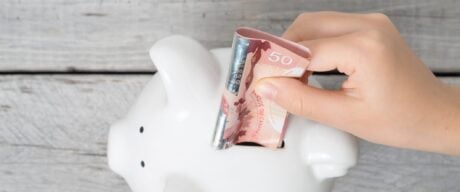Debt is something that many Canadians deal with: The average Canadian owes $73,532, according to an Equifax study from September 2020. Mortgages are the biggest contributor to that number, but most Canadians juggle several other types of debt. Before you can come up with a plan to pay off your debt, it’s important to understand the different types of debt and how they work.
Secured debt vs. unsecured debt
The first thing to understand is the difference between the two main types of debt: secured and unsecured. Unsecured debt has no collateral behind it; the lender trusts that you will pay back the money in a timely manner based on your credit history. Most credit cards are unsecured, but you still need to pay them off. If you don’t pay unsecured debts, you’ll face penalties and fees, damage your credit score, and likely be contacted by debt collectors.
Secured debts, on the other hand, are backed by collateral, like a house. If you default on the loan, the lender can use that collateral to pay off the funds you borrowed. For example, a mortgage is a secured debt. As long as you make your payments, you’re doing well. But if you default on your payments repeatedly, you risk losing your home.
Good debt vs. bad debt
Sometimes, debt is also divided into categories of good debt and bad debt.
Good debts are considered to add value or increase your net worth, such as student loans or a mortgage. The first can help you earn more income, and the second helps you buy an asset that will typically increase in value over time.
Bad debts, however, typically do not increase in value and can even hurt you financially over time. For example, credit card debt falls into this category.
Whether a debt counts as good or bad can also depend on your circumstances. For example, a mortgage is usually considered good debt, but if you buy a house that’s too expensive for your budget and can’t afford the payments, it could quickly become bad debt.
» MORE: Spend and save wisely with a budget
Types of debt
Credit card debt
Credit card debt is the second-most-common type of debt for Canadians, according to the 2019 Canadian Financial Capability Survey. This unsecured debt falls into the bad debt category. It also comes with some of the highest interest rates of any type of debt, often around 19%, which means it’s in your best interest to pay off credit card debt as quickly as possible. At the very least, make sure that you’re making your minimum monthly payments, and ideally paying more than the minimum.
Need some tips to help pay off credit card debt?
- Look into transferring your balance to a credit card with a 0% promotional interest rate, or at least a lower interest rate than your current card.
- Put any extra money in your budget towards your credit card balance, so you pay more than the minimum payment each month.
- Pay off your credit card debt with the highest interest rate first.
Student loans
A student loan is unsecured debt but is generally considered good debt since it will hopefully help you earn a higher salary. Typically, you don’t have to start paying back these types of loans until after you leave school. Still, it depends on the type of loan (e.g., federal student loan, provincial student loan, or student line of credit from a financial institution). Usually, you’ll need to start paying back the loan (plus interest) within 4-6 months of graduation. However, keep in mind that interest may still accrue during this so-called grace period.
Here are some helpful tips for paying off your student loans:
- If you can start paying back your student loan during the grace period or even while you’re still in school, you’ll reduce the balance — and pay less interest over time.
- Pay more than the minimum payment. Any extra will go towards the principal, which will help reduce the amount of interest you’ll pay.
- If you’re struggling to pay your loan, look into the Repayment Assistance Plan (RAP)
- If you have multiple provincial or federal student loans, do not consolidate or refinance them with a private lender. The interest rates charged by the government are generally lower than those you’ll get from a private lender, plus you may be eligible for debt relief programs.
- If you have a government student loan, don’t forget to claim your interest charges as a tax credit. You can’t deduct interest paid on private loans — another reason to think twice before refinancing or consolidating student loans.
Medical debt
While many medical costs are covered under Canada’s health care system, you may still need to pay out of pocket for things like prescriptions, counselling, and dental care if you don’t have additional insurance coverage. Medical debt is unsecured and typically doesn’t come with a payback plan; you’ll often simply receive a bill.
If you’re unable to pay the full amount at once, you can:
- Speak to the provider’s billing department about setting up a payment plan or negotiating some of the costs.
- Consider paying with a low or 0% APR credit card, as long as you’ll be able to pay off the balance by the end of the promotional period.
- Look for support from nonprofits or charities that help people in need, which may offer lower-cost access to medical services or equipment like wheelchairs and crutches.
Remember to keep track of all medical expenses, because you may be eligible to deduct them on your tax return if they exceed 3% of your income (or $2,397, whichever is less).
Personal loans
You may have taken out a personal loan to cover the costs of renovating your home or to help you consolidate other kinds of debt. Depending on your circumstances, personal loans can be secured or unsecured. Interest rates on personal loans may be fixed or variable, and they vary greatly based on the lender and your credit history.
If you’re struggling to make your personal loan payments, you may want to:
- Contact your lender and ask to renegotiate your loan. You could ask for smaller payments, a lower interest rate, or a longer term, though these changes mean you’ll take longer to pay off the debt
- Talk to a credit counsellor
- Consider negotiating a personal loan settlement
Mortgage
Mortgages are secured loans backed by your home, and they’re often considered good debt. When you apply for a mortgage, you agree to pay it back in instalments, such as biweekly or monthly, over a certain length of time. Your mortgage term, interest rate, and prepayment options will vary depending on your agreement with the lender and credit history.
If you’re unable to keep up with your mortgage payments, the lender can foreclose on your home. To avoid this situation, look into:
- Asking for a mortgage deferral, which allows you to take a break from making payments for a certain length of time (though interest will still accrue)
- Lowering your mortgage payments and extending your mortgage term
- Selling your home and moving to a more affordable option
Auto loans
If you buy a vehicle and can’t afford the full amount, you may take out an auto loan. Car loans are secured debt; your car can be repossessed if you default on the payments you agree to make in instalments over the course of a certain time period.
If you’re struggling to make your auto loan payments, consider:
- Selling your vehicle and switching to a more affordable option, or relying on other forms of transportation
- Refinancing your car loan
FAQs
A loan is a form of debt— it’s money you borrow and agree to pay back eventually. Debt is the amount that you owe, which is usually higher than the amount you borrowed because of interest. Debt also includes credit card debt and medical debt, which aren’t generally referred to as loans.
Ideally, you should keep track of your debt on your own through your bank account, credit card statements, and student loan account. However, if you need assistance confirming your debt, request a copy of your credit report from Equifax Canada or TransUnion Canada. The report will show a list of debts that have been reported to the credit bureau, so you have a clearer picture of what you owe.
DIVE EVEN DEEPER

What Is Debt and How to Handle It
Debt is money owed by one party to another. The best way to handle it depends on the type of debt you have.

Budgeting 101: How to Budget Your Money
A budget is a plan that helps you manage your money so you can spend and save wisely. Learn how to make a budget — and how to stick to it.

How to Save Money in 8 Easy Steps
Trying to save money but not sure where to start? Follow these steps and watch your money grow.

